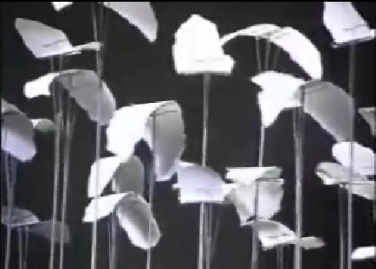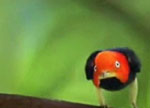 |
→ February 2006 Contents → Column
|
E-Bits - Reality, Inventiveness and Moonwalking
|
 |
|
It is debatable whether reality has ever ruled in our lifetime, and if it has, has it done so for long? As my Swedish friend Rikki said of his own culture over 20 years ago, "My God, what a society!" Here in America, fantasy is in, and art imitates life imitates art imitates life. In the realm of politics, it doesn't take an elected official to spin reality--we have whopper-telling civilians, some even on the federal payroll, whose job it is to manipulate our perceptions. A good portion of our print media and news broadcasters are doing a fine job of confusing us, and we've been told by our supposedly most trusted voice of all, in case we didn't already know it, that "repetition is good for catapulting the propaganda." Film has replaced actual real-life for creating cultural norms and spawning sociological debate. Any minute of any day, one can tune into powerful interactive experience on the Internet, which in reality is comprised only of electronic images and audio, that can take you on a fantasy trip, give you a quiz, determine your preferences, assess your intellect, analyze your personality, or even let you WebCam yourself to Timbuktu--all via nothing more than illusion in light and sound. These illusions may have consequences, but we're not always aware of what they are. Our privacy is a thing of the past; our lives are an open book (or an open laptop). There is lots to be lost and much to be found in cyberspace, in the land of unreality. Where we will end up is anybody's guess. Click on the image and check out this satellite zoom all the way from outer space to the location where much of our collective consciousness and orientation to reality is determined. As the zoom proceeds, try to guess where it will end up.
In the land of unreality, we have digital cameras and Photoshop to manipulate images, and film and TV programs to shape our thoughts. Video ads for commercial products amaze and astound us whether they have anything to do with the verity of the product or not. Inventive minds come up with multiple ways to delight us either photographically, through art or with mechanical creations, and we are content to look at just about anything point blank these days, as long as it fits an emerging paradigm--that is, it must somehow be not quite real. If we know something is a fabrication, it can be quite graphic, violent, even disturbingly gory. But if it is real, it must be well edited, sanitized or censored. We have heard for years now that we are co-creators of reality--that "reality is what you make it." No one can argue the fact that our current leaders have jumped on that bandwagon, telling us, "reality is what we say it is." To deal with all the confusion, millions of people dull or intensify their perceptions with mood-altering prescription drugs worthy of Vonnegut's Monkey House, and even Toto knows we are not in Kansas anymore. It seems like some are trying to buy real estate--or even doing a land-grab--to move permanently to the Land of Oz. Whatever is the case, it's not boring these days, and some have become more creative than ever. Consider these photo-illustrations, which arrived over e-mail, entitled "When Graphic Designers Get Bored."
While technology may help us to ponder or deal with reality, it can also help us to escape. Occasionally something real or authentic truly astonishes, and it's usually because it is hard to believe. Many have seen the following video advertisement by Honda, so we present it here again to remind ourselves that while some hard-liners wish for a seamless domino effect that isn't happening in the real world, Honda created one on video that is satisfying to watch again and again. It took 606 takes to perfect the sequence, and we have it on good authority that the final video is the unedited combination of two of those takes. The precision in this piece is hard to believe, or as the French say, "Incroyable!"
Similarly inventive and stimulating to the imagination are two mechanical devices, obviously created by their maker for amusement, artistic expression, and tribute. The purpose seems to be for none other than tickling one's fancy and perhaps showing what emerges from the mind of a talented, creative soul. We don't know the name of the inventor, but join me in pure delight as you see these two little machines, "Twenty-Three Scraps" and "Homage to Tinguely's 'Homage á Marcel Duchamp.'" We found both on eBaum's World.
Last but not least, here is little video clip from nature that touches the heart, stimulates a feeling of wonder, and gives a surprise laugh all at the same time. Best of all, it is real. Remember how we felt when we first saw Michael Jackson moonwalking? How DID he do that? Well, now you will see a rare bird indeed that has Jackson's moves down pat--the jungle-dancing, moonwalking Manakin, native to Latin America--presented by Dr. Kimberly Bostwick, Curator of Birds and Mammals at Cornell University, as recently seen on PBS.
Whether you are entrenched in reality, escaping to the world of fantasy, or inventing new ways to delight the mind, dance a jig, or just deal with what's happening, keep your head and have a great February.
© Beverly Spicer
|
|
Back to February 2006 Contents
|
|








